Netgear WNDR4500v2 Owner's Manual
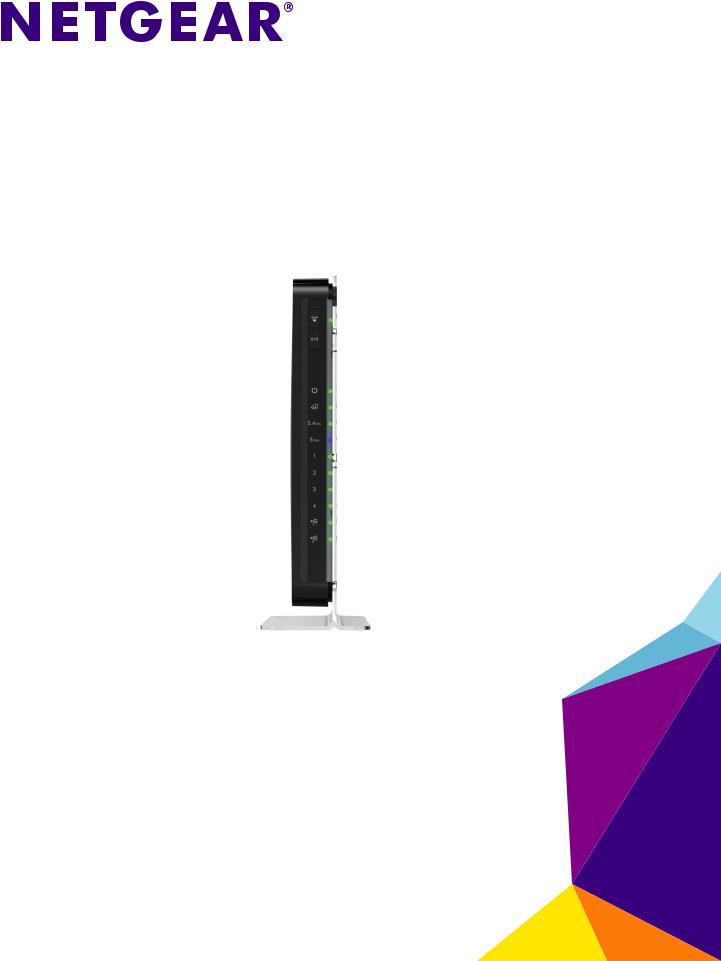
N900 Wireless Dual Band Gigabit
Router WNDR4500v2
User Manual
September 2013 202-11130-02
350 East Plumeria Drive
San Jose, CA 95134
USA

N900 Wireless Dual Band Gigabit Router WNDR4500v2
Support
Thank you for choosing NETGEAR.
After installing your device, locate the serial number on the label of your product and use it to register your product at https://my.netgear.com. You must register your product before you can use NETGEAR telephone support. NETGEAR recommends registering your product through the NETGEAR website. For product updates and web support, visit http://support.netgear.com.
Phone (US & Canada only): 1-888-NETGEAR.
Phone (Other Countries): Check the list of phone numbers at http://support.netgear.com/general/contact/default.aspx.
NETGEAR recommends that you use only the official NETGEAR support resources.
Trademarks
NETGEAR, the NETGEAR logo, and Connect with Innovation are trademarks and/or registered trademarks of NETGEAR, Inc. and/or its subsidiaries in the United States and/or other countries. Information is subject to change without notice. © NETGEAR, Inc. All rights reserved.
2

Contents
Chapter 1 Hardware Setup
Unpack Your Router. . . . . . . . . . . . . . . . . . . . . . . . . . . . . . . . . . . . . . . . . . . 8
Position Your Router . . . . . . . . . . . . . . . . . . . . . . . . . . . . . . . . . . . . . . . . . . 8
Hardware Features. . . . . . . . . . . . . . . . . . . . . . . . . . . . . . . . . . . . . . . . . . . . 9
Front Panel . . . . . . . . . . . . . . . . . . . . . . . . . . . . . . . . . . . . . . . . . . . . . . . . 9
Back Panel . . . . . . . . . . . . . . . . . . . . . . . . . . . . . . . . . . . . . . . . . . . . . . . 11
Label. . . . . . . . . . . . . . . . . . . . . . . . . . . . . . . . . . . . . . . . . . . . . . . . . . . . 12
Chapter 2 Getting Started with NETGEAR genie
Router Setup Preparation. . . . . . . . . . . . . . . . . . . . . . . . . . . . . . . . . . . . . . 14 Use Standard TCP/IP Properties for DHCP . . . . . . . . . . . . . . . . . . . . . . 14 Gather ISP Information. . . . . . . . . . . . . . . . . . . . . . . . . . . . . . . . . . . . . . 14 Wireless Devices and Security Settings . . . . . . . . . . . . . . . . . . . . . . . . . 14 Types of Logins and Access. . . . . . . . . . . . . . . . . . . . . . . . . . . . . . . . . . . . 14 NETGEAR genie Setup . . . . . . . . . . . . . . . . . . . . . . . . . . . . . . . . . . . . . . . 15 Use NETGEAR genie after Installation. . . . . . . . . . . . . . . . . . . . . . . . . . . . 16 Upgrade Router Firmware . . . . . . . . . . . . . . . . . . . . . . . . . . . . . . . . . . . . . 16 Router Dashboard (Basic Home Screen) . . . . . . . . . . . . . . . . . . . . . . . . . . 17 Add Wireless Devices or Computers to Your Network . . . . . . . . . . . . . . . .18 Manual Method. . . . . . . . . . . . . . . . . . . . . . . . . . . . . . . . . . . . . . . . . . . . 18 Wi-Fi Protected Setup (WPS) Method . . . . . . . . . . . . . . . . . . . . . . . . . . 18 NETGEAR genie App and Mobile genie App . . . . . . . . . . . . . . . . . . . . . . . 19
Chapter 3 NETGEAR genie Basic Settings
Internet Setup. . . . . . . . . . . . . . . . . . . . . . . . . . . . . . . . . . . . . . . . . . . . . . . 21
Internet Setup Screen Fields . . . . . . . . . . . . . . . . . . . . . . . . . . . . . . . . . 21
Attached Devices . . . . . . . . . . . . . . . . . . . . . . . . . . . . . . . . . . . . . . . . . . . . 23
Parental Controls . . . . . . . . . . . . . . . . . . . . . . . . . . . . . . . . . . . . . . . . . . . . 24
ReadySHARE USB Storage. . . . . . . . . . . . . . . . . . . . . . . . . . . . . . . . . . . . 24
Basic Wireless Settings . . . . . . . . . . . . . . . . . . . . . . . . . . . . . . . . . . . . . . . 25
Wireless Settings Screen Fields. . . . . . . . . . . . . . . . . . . . . . . . . . . . . . . 26
Change WPA Security Option and Passphrase . . . . . . . . . . . . . . . . . . . 27
Guest Networks . . . . . . . . . . . . . . . . . . . . . . . . . . . . . . . . . . . . . . . . . . . . . 28
Guest Network Wireless Security Options . . . . . . . . . . . . . . . . . . . . . . . 29
Chapter 4 NETGEAR genie Advanced Home
Setup Wizard . . . . . . . . . . . . . . . . . . . . . . . . . . . . . . . . . . . . . . . . . . . . . . . 31
WPS Wizard . . . . . . . . . . . . . . . . . . . . . . . . . . . . . . . . . . . . . . . . . . . . . . . . 32
3

N900 Wireless Dual Band Gigabit Router WNDR4500v2
Setup Menu . . . . . . . . . . . . . . . . . . . . . . . . . . . . . . . . . . . . . . . . . . . . . . . . 33
WAN Setup. . . . . . . . . . . . . . . . . . . . . . . . . . . . . . . . . . . . . . . . . . . . . . . . . 34
Default DMZ Server . . . . . . . . . . . . . . . . . . . . . . . . . . . . . . . . . . . . . . . . 35
Change the MTU Size . . . . . . . . . . . . . . . . . . . . . . . . . . . . . . . . . . . . . . 35
LAN Setup . . . . . . . . . . . . . . . . . . . . . . . . . . . . . . . . . . . . . . . . . . . . . . . . . 37
LAN Setup Screen Settings . . . . . . . . . . . . . . . . . . . . . . . . . . . . . . . . . . 38
Use the Router as a DHCP Server. . . . . . . . . . . . . . . . . . . . . . . . . . . . . 38
Address Reservation . . . . . . . . . . . . . . . . . . . . . . . . . . . . . . . . . . . . . . . 39
Quality of Service (QoS) Setup . . . . . . . . . . . . . . . . . . . . . . . . . . . . . . . . . 40
Chapter 5 USB Storage
USB Drive Requirements . . . . . . . . . . . . . . . . . . . . . . . . . . . . . . . . . . . . . . 46 ReadySHARE Access . . . . . . . . . . . . . . . . . . . . . . . . . . . . . . . . . . . . . . . . 46 TiVo . . . . . . . . . . . . . . . . . . . . . . . . . . . . . . . . . . . . . . . . . . . . . . . . . . . . . . 47 File-Sharing Scenarios . . . . . . . . . . . . . . . . . . . . . . . . . . . . . . . . . . . . . . . . 47 Basic Settings. . . . . . . . . . . . . . . . . . . . . . . . . . . . . . . . . . . . . . . . . . . . . . . 48
Add or Edit a Network Folder . . . . . . . . . . . . . . . . . . . . . . . . . . . . . . . . . 50 USB Storage Advanced Settings . . . . . . . . . . . . . . . . . . . . . . . . . . . . . . . . 51 Safely Remove a USB Drive . . . . . . . . . . . . . . . . . . . . . . . . . . . . . . . . . . . 52 Media Server Settings . . . . . . . . . . . . . . . . . . . . . . . . . . . . . . . . . . . . . . . . 52 Specify Approved USB Devices . . . . . . . . . . . . . . . . . . . . . . . . . . . . . . . . . 53 Connect to the USB Drive from a Remote Computer. . . . . . . . . . . . . . . . . 54
Access the Router’s USB Drive Remotely Using FTP . . . . . . . . . . . . . . 54 ReadySHARE Cloud . . . . . . . . . . . . . . . . . . . . . . . . . . . . . . . . . . . . . . . . . 55 Time Machine. . . . . . . . . . . . . . . . . . . . . . . . . . . . . . . . . . . . . . . . . . . . . . . 56 Set Up Time Machine . . . . . . . . . . . . . . . . . . . . . . . . . . . . . . . . . . . . . . . 56 Access the Connected USB Hard Drive . . . . . . . . . . . . . . . . . . . . . . . . . 57 Before You Back Up a Large Amount of Data . . . . . . . . . . . . . . . . . . . . 58 Change the Partition Scheme. . . . . . . . . . . . . . . . . . . . . . . . . . . . . . . . . 60
Chapter 6 ReadySHARE Printer
ReadySHARE Printer . . . . . . . . . . . . . . . . . . . . . . . . . . . . . . . . . . . . . . . . . 63 USB Control Center Utility . . . . . . . . . . . . . . . . . . . . . . . . . . . . . . . . . . . . . 67 Control Center Configuration . . . . . . . . . . . . . . . . . . . . . . . . . . . . . . . . . 68 USB Printer. . . . . . . . . . . . . . . . . . . . . . . . . . . . . . . . . . . . . . . . . . . . . . . 68 Scan with a Multifunction Printer . . . . . . . . . . . . . . . . . . . . . . . . . . . . . . 69 USB Speaker . . . . . . . . . . . . . . . . . . . . . . . . . . . . . . . . . . . . . . . . . . . . . 69
Chapter 7 Security
Keyword Blocking of HTTP Traffic . . . . . . . . . . . . . . . . . . . . . . . . . . . . . . . 71
Block Services (Port Filtering) . . . . . . . . . . . . . . . . . . . . . . . . . . . . . . . . . . 72
Schedule Blocking . . . . . . . . . . . . . . . . . . . . . . . . . . . . . . . . . . . . . . . . . . . 74
Security Event Email Notifications . . . . . . . . . . . . . . . . . . . . . . . . . . . . . . . 75
4

N900 Wireless Dual Band Gigabit Router WNDR4500v2
Chapter 8 Administration
Upgrade the Router Firmware . . . . . . . . . . . . . . . . . . . . . . . . . . . . . . . . . .77 View Router Status. . . . . . . . . . . . . . . . . . . . . . . . . . . . . . . . . . . . . . . . . . .78 Router Information . . . . . . . . . . . . . . . . . . . . . . . . . . . . . . . . . . . . . . . . .78 Internet Port . . . . . . . . . . . . . . . . . . . . . . . . . . . . . . . . . . . . . . . . . . . . . .78 Wireless Settings (2.4 GHz and 5 GHz) . . . . . . . . . . . . . . . . . . . . . . . . .81 Guest Network (2.4 GHz and 5 GHz) . . . . . . . . . . . . . . . . . . . . . . . . . . .82 View Logs of Web Access or Attempted Web Access . . . . . . . . . . . . . . . .82 Manage the Configuration File . . . . . . . . . . . . . . . . . . . . . . . . . . . . . . . . . .84 Back Up Settings . . . . . . . . . . . . . . . . . . . . . . . . . . . . . . . . . . . . . . . . . .84 Restore Configuration Settings. . . . . . . . . . . . . . . . . . . . . . . . . . . . . . . .84 Erase . . . . . . . . . . . . . . . . . . . . . . . . . . . . . . . . . . . . . . . . . . . . . . . . . . .85 Set Password . . . . . . . . . . . . . . . . . . . . . . . . . . . . . . . . . . . . . . . . . . . . . . .85 Password Recovery . . . . . . . . . . . . . . . . . . . . . . . . . . . . . . . . . . . . . . . .85
Chapter 9 Advanced Settings
Advanced Wireless Settings. . . . . . . . . . . . . . . . . . . . . . . . . . . . . . . . . . . .88 Wireless Repeating Function . . . . . . . . . . . . . . . . . . . . . . . . . . . . . . . . . . .89 Wireless Repeating Function . . . . . . . . . . . . . . . . . . . . . . . . . . . . . . . . .90 Set Up the Base Station . . . . . . . . . . . . . . . . . . . . . . . . . . . . . . . . . . . . .91 Set Up a Repeater Unit. . . . . . . . . . . . . . . . . . . . . . . . . . . . . . . . . . . . . .92 Port Forwarding and Port Triggering . . . . . . . . . . . . . . . . . . . . . . . . . . . . .93 Remote Computer Access Basics . . . . . . . . . . . . . . . . . . . . . . . . . . . . .93 Port Triggering to Open Incoming Ports . . . . . . . . . . . . . . . . . . . . . . . . .94 Port Forwarding to Permit External Host Communications . . . . . . . . . .95 How Port Forwarding Differs from Port Triggering . . . . . . . . . . . . . . . . .96 Set Up Port Forwarding to Local Servers . . . . . . . . . . . . . . . . . . . . . . . . . .97 Add a Custom Service . . . . . . . . . . . . . . . . . . . . . . . . . . . . . . . . . . . . . .98 Edit or Delete a Port Forwarding Entry . . . . . . . . . . . . . . . . . . . . . . . . . .99 Set Up Port Triggering . . . . . . . . . . . . . . . . . . . . . . . . . . . . . . . . . . . . . . . .99 Dynamic DNS . . . . . . . . . . . . . . . . . . . . . . . . . . . . . . . . . . . . . . . . . . . . . .101 Static Routes . . . . . . . . . . . . . . . . . . . . . . . . . . . . . . . . . . . . . . . . . . . . . .103 Remote Management . . . . . . . . . . . . . . . . . . . . . . . . . . . . . . . . . . . . . . . .105 USB Settings . . . . . . . . . . . . . . . . . . . . . . . . . . . . . . . . . . . . . . . . . . . . . .106 Universal Plug and Play . . . . . . . . . . . . . . . . . . . . . . . . . . . . . . . . . . . . . .106 IPv6 . . . . . . . . . . . . . . . . . . . . . . . . . . . . . . . . . . . . . . . . . . . . . . . . . . . . .108 Traffic Meter . . . . . . . . . . . . . . . . . . . . . . . . . . . . . . . . . . . . . . . . . . . . . . .109
Chapter 10 Troubleshooting
Quick Tips. . . . . . . . . . . . . . . . . . . . . . . . . . . . . . . . . . . . . . . . . . . . . . . . .111 Sequence to Restart Your Network . . . . . . . . . . . . . . . . . . . . . . . . . . .111 Check Ethernet Cable Connections . . . . . . . . . . . . . . . . . . . . . . . . . . .111 Wireless Settings . . . . . . . . . . . . . . . . . . . . . . . . . . . . . . . . . . . . . . . . .111 Network Settings. . . . . . . . . . . . . . . . . . . . . . . . . . . . . . . . . . . . . . . . . .111
Troubleshooting with the LEDs. . . . . . . . . . . . . . . . . . . . . . . . . . . . . . . . .112 Power/Test LED Is Off or Blinking . . . . . . . . . . . . . . . . . . . . . . . . . . . .112
5

N900 Wireless Dual Band Gigabit Router WNDR4500v2
Power/Test LED Stays Amber . . . . . . . . . . . . . . . . . . . . . . . . . . . . . . . 112 LEDs Never Turn Off . . . . . . . . . . . . . . . . . . . . . . . . . . . . . . . . . . . . . . 113 Internet or Ethernet Port LEDs Are Off. . . . . . . . . . . . . . . . . . . . . . . . . 113 Wireless LEDs Are Off . . . . . . . . . . . . . . . . . . . . . . . . . . . . . . . . . . . . . 113 The Push 'N' Connect (WPS) Button Blinks Amber . . . . . . . . . . . . . . . 113
Cannot Log In to the Router . . . . . . . . . . . . . . . . . . . . . . . . . . . . . . . . . . . 114 Cannot Access the Internet . . . . . . . . . . . . . . . . . . . . . . . . . . . . . . . . . . . 114 Troubleshooting PPPoE . . . . . . . . . . . . . . . . . . . . . . . . . . . . . . . . . . . . 116 Troubleshooting Internet Browsing. . . . . . . . . . . . . . . . . . . . . . . . . . . . 116 Changes Not Saved . . . . . . . . . . . . . . . . . . . . . . . . . . . . . . . . . . . . . . . . . 117 Wireless Connectivity . . . . . . . . . . . . . . . . . . . . . . . . . . . . . . . . . . . . . . . . 117 Wireless Signal Strength . . . . . . . . . . . . . . . . . . . . . . . . . . . . . . . . . . . 117 Restore the Factory Settings and Password . . . . . . . . . . . . . . . . . . . . . . 118 Troubleshoot Your Network Using the Ping Utility . . . . . . . . . . . . . . . . . . 118 Test the LAN Path to Your Router . . . . . . . . . . . . . . . . . . . . . . . . . . . . 118 Test the Path from Your Computer to a Remote Device . . . . . . . . . . . 119
Appendix A Supplemental Information
Factory Settings . . . . . . . . . . . . . . . . . . . . . . . . . . . . . . . . . . . . . . . . . . . . 121
Technical Specifications. . . . . . . . . . . . . . . . . . . . . . . . . . . . . . . . . . . . . . 122
Appendix B Notification of Compliance
6

1. Hardware Setup |
1 |
Getting to know your router |
The N900 Wireless Dual Band Gigabit Router WNDR4500v2 provides you with an easy and secure way to set up a home network with fast access to the Internet over a high-speed digital subscriber line (DSL). It is compatible with all major DSL Internet service providers, lets you block unsafe Internet content and applications, and protects the devices (computers, gaming consoles, and so on) that you connect to your home network.
If you have not already set up your new router using the installation guide that comes in the box, this chapter walks you through the hardware setup. Chapter 2, Getting Started with NETGEAR genie, explains how to set up your Internet connection.
This chapter contains the following sections:
•Unpack Your Router
•Position Your Router
•Hardware Features
For information about ReadySHARE features in your product, see Chapter 5, USB Storage, and visit www.netgear.com/readyshare.
For more information about the topics covered in this manual, visit the support website at http://support.netgear.com.
7
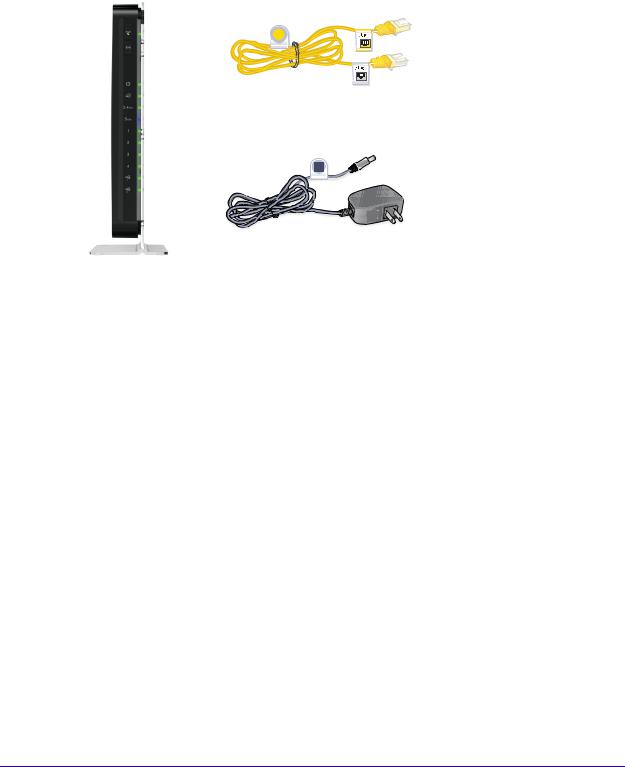
N900 Wireless Dual Band Gigabit Router WNDR4500v2
Unpack Your Router
Open the box and remove the router, cables, and installation guide.
Ethernet cable
Power adapter
N900 Wireless Router
(with stand attached)
Figure 1. Check the package contents
Your box should contain the following items:
•N900 Wireless Dual Band Gigabit Router WNDR4500v2
•AC power adapter (plug varies by region)
•Category 5 (Cat 5E) Ethernet cable
•Installation guide with cabling and router setup instructions
Position Your Router
The router lets you access your network from virtually anywhere within the operating range of your wireless network. However, the operating distance or range of your wireless connection can vary significantly depending on the physical placement of your router. For example, the thickness and number of walls the wireless signal passes through can limit the range. For best results, place your router:
•Near the center of the area where your computers and other devices operate, and preferably within line of sight to your wireless devices.
•So it is accessible to an AC power outlet and near Ethernet cables for wired computers.
•In an elevated location such as a high shelf, keeping the number of walls and ceilings between the router and your other devices to a minimum.
Hardware Setup
8
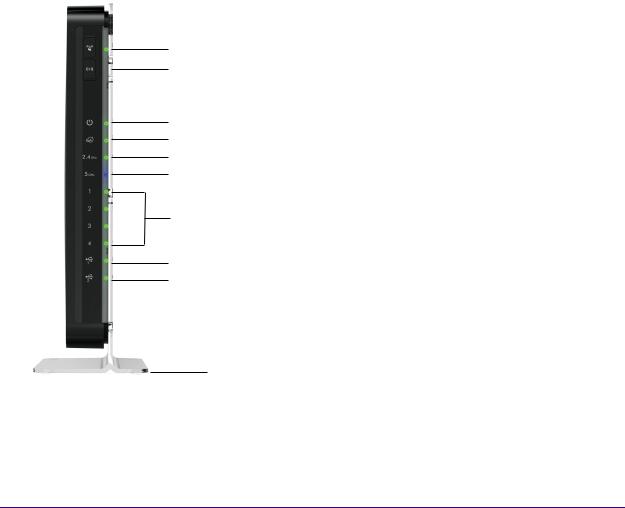
N900 Wireless Dual Band Gigabit Router WNDR4500v2
•Away from electrical devices that are potential sources of interference, such as ceiling fans, home security systems, microwaves, computers, or the base of a cordless phone or 2.4 GHz cordless phone.
•Away from any large metal surfaces, such as a solid metal door or aluminum studs. Large expanses of other materials such as glass, insulated walls, fish tanks, mirrors, brick, and concrete can also affect your wireless signal.
When you use multiple access points, it is better if adjacent access points use different radio frequency channels to reduce interference. The recommended channel spacing between adjacent access points is 5 channels. (For example, use Channels 1 and 6, or 6 and 11).
Hardware Features
Before you cable your router, take a moment to become familiar with the label and the front and back panels. Pay particular attention to the LEDs on the front panel.
Front Panel
The router front panel has the status LEDs and icons shown in the following figure.
WPS button and LED
WFi On/Off button
Power
Internet
2.4-wireless network
5-GHz wireless network
Etherent LAN ports 1–4
USB port 1
USB port 2
Router stand (attached)
Figure 2. Router, front view
Hardware Setup
9

N900 Wireless Dual Band Gigabit Router WNDR4500v2
Table 1. Front panel LED descriptions
|
LED |
|
|
Description |
||||
|
|
|
|
|
||||
|
Power/Test |
|
|
• Solid amber. The router is starting up after being powered on. |
||||
|
|
|
|
|
|
|
|
• Solid green. The power is on, and the router is ready. |
|
|
|
|
|
|
|||
|
|
|
|
|
|
|
|
• Blinking amber. A firmware update is in progress. |
|
|
|
|
|
|
|||
|
|
|
|
|
|
|
|
• Blinking green. The firmware is corrupt. |
|
|
|
|
|
|
|
|
• Switching between green and amber. The router is in AP Bridge mode. |
|
|
|
|
|
|
|
|
• Off. Power is not supplied to the router. |
|
|
|
|
|
||||
|
Internet |
|
|
• Solid green. An IP address has been received. The router is ready to transmit data. |
||||
|
|
|
|
|
|
|
|
• Solid amber. The IP address has not been acquired. |
|
|
|
|
|
|
|||
|
|
|
|
|
|
|
|
• Off. No Ethernet cable is connected between the router and the modem. |
|
|
|
|
|
|
|||
|
|
|
|
|
||||
|
2.4 GHz |
|
|
• Solid green. The wireless radio is operating. |
||||
|
|
|
|
|
|
|
|
• Blinking. The router is in WPS mode |
|
|
|
|
|
|
|||
|
|
|
|
|
|
|
|
• Off. The wireless radio is off. |
|
|
|
|
|
|
|||
|
|
|
|
|
||||
|
5 GHz |
|
|
• Solid blue. The wireless radio is operating. |
||||
|
|
|
|
|
|
|
|
• Blinking. The router is in WPS mode. |
|
|
|
|
|
|
|||
|
|
|
|
|
|
|
|
• Off. The wireless radio is off. |
|
|
|
|
|
|
|||
|
|
|
|
|
||||
|
LAN ports |
|
|
|
||||
|
1–4 |
|
|
• Solid green. The LAN port has detected a 1,000 Mbps link with an attached device. |
||||
|
|
|
|
|
|
|
|
|
|
|
|
|
|
|
|
|
• Solid amber. The LAN port has detected a 10/100 Mbps link with an attached device. |
|
|
|
|
|
|
|
|
• Off. No link is detected on this port. |
|
|
|
|
|
|
|||
|
|
|
|
|
|
|
||
|
|
|
|
|
||||
|
USB 1 and |
|
|
• Solid green. The router has accepted the USB device. The USB device is ready to be used. |
||||
|
USB 2 |
|
|
• Blinking green. The USB device is in use. |
||||
|
|
|
|
|
|
|
|
• Off. No USB device is connected, or the Safely Remove Hardware button has been clicked |
|
|
|
|
|
|
|
|
and it is now safe to remove the attached USB device. |
|
|
|
|
|
|
|
||
|
|
|
|
|
|
|
|
|
The WiFi On/Off and WPS buttons toggle the wireless and WPS functions on and off.
• |
WiFi On/Off button. Pressing and holding the wireless LAN button for 2 seconds |
|
turns on and off the 2.4-GHz and 5-GHz wireless radios. If the 2.4 GHz and 5 GHz LEDs |
|
are lit, the wireless radios are on. If these LEDs are off, the wireless radios are turned off |
|
and you cannot connect wirelessly to the router. |
• |
WPS button. You can use this button to use WPS to add a wireless device or |
|
computer to your wireless network. The LED below the WPS button blinks green when |
|
the router is trying to add the wireless device or computer. The LED stays solid green |
|
when wireless security is enabled in the router. |
Hardware Setup
10

N900 Wireless Dual Band Gigabit Router WNDR4500v2
Back Panel
The back panel has the connections shown in the following figure.
USB ports
LAN Ethernet ports 1–4
Internet port
Reset button
Power
Power On/Off button
Figure 3. Router, rear view
See Factory Settings on page 121 for information about restoring factory settings.
Hardware Setup
11
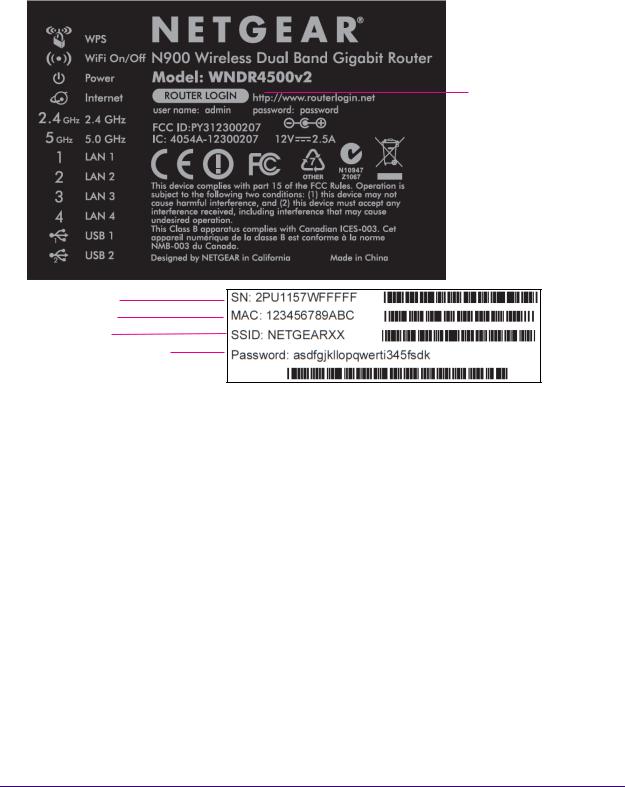
N900 Wireless Dual Band Gigabit Router WNDR4500v2
Label
The router label shows the login information. The white label shows the unique serial number, MAC address, preset SSID, and preset WiFi password.
Login information
Serial number
MAC address
Preset SSID
Preset WiFi Password
Figure 4. The white label shows unique information about your router
Hardware Setup
12

2. Getting Started with NETGEAR |
2 |
genie |
Connecting to the router
This chapter explains how to use NETGEAR genie to set up your router after you complete cabling as described in the installation guide and in the previous chapter in this book.
This chapter contains the following sections:
•Router Setup Preparation
•Types of Logins and Access
•NETGEAR genie Setup
•Use NETGEAR genie after Installation
•Upgrade Router Firmware
•Router Dashboard (Basic Home Screen)
•Add Wireless Devices or Computers to Your Network
•NETGEAR genie App and Mobile genie App
13

N900 Wireless Dual Band Gigabit Router WNDR4500v2
Router Setup Preparation
You can set up your router with the NETGEAR genie automatically, or you can use the NETGEAR genie menus and screens to set up your router manually. However, before you start the setup process, you need to have your ISP information on hand and make sure the laptops, computers, and other devices in the network have the settings described here.
Use Standard TCP/IP Properties for DHCP
If you set up your computer to use a static IP address, you need to change the settings so that it uses Dynamic Host Configuration Protocol (DHCP).
Gather ISP Information
If you have DSL broadband service, you might need the following information to set up your router and to check that your Internet configuration is correct. Your Internet service provider (ISP) should have provided you with all of the information needed to connect to the Internet. If you cannot locate this information, ask your ISP to provide it. When your Internet connection is working, you no longer need to launch the ISP login program on your computer to access the Internet. When you start an Internet application, your router automatically logs you in.
•The ISP configuration information for your DSL account
•ISP login name and password
•Fixed or static IP address settings (special deployment by ISP; this is rare)
Wireless Devices and Security Settings
Make sure that the wireless device or computer that you are using supports WPA or WPA2 wireless security, which is the wireless security supported by the router.
Types of Logins and Access
There are separate types of logins that have different purposes. It is important that you understand the difference so that you know which login to use when.
•Router login logs you in to the router interface from NETGEAR genie. See Use NETGEAR genie after Installation on page 16 for details about this login.
•ISP login logs you in to your Internet service. Your service provider has provided you with this login information in a letter or some other way. If you cannot find this login information, contact your service provider.
•Wireless network key or password. Your router is preset with a unique wireless network name (SSID) and password for wireless access. This information is on the label on the bottom of your router.
Getting Started with NETGEAR genie
14

N900 Wireless Dual Band Gigabit Router WNDR4500v2
NETGEAR genie Setup
NETGEAR genie runs on any device with a web browser. It is the easiest way to set up the router because it automates many of the steps and verifies that those steps have been successfully completed. It takes about 15 minutes to complete.
To use NETGEAR genie to set up your router:
1.Turn the router on by pressing the On/Off button, if not done yet.
2.Make sure that your device is connected with an Ethernet cable (wired) or wirelessly (with the preset security settings listed on the bottom label) to your router.
3.Launch your Internet browser.
•The first time you set up the Internet connection for your router, the browser automatically goes to http://www.routerlogin.net, and the NETGEAR genie screen displays.
•If you already used the NETGEAR genie, type http://www.routerlogin.net in the address field for your browser to display the NETGEAR genie screen. See Use NETGEAR genie after Installation on page 16.
4.Follow the onscreen instructions to complete NETGEAR genie setup. NETGEAR genie guides you through connecting the router to the Internet.
If the browser cannot display the web page:
•Make sure that the computer is connected to one of the four LAN Ethernet ports, or wirelessly to the router.
•Make sure that the Power LED and Wireless LED are lit.
•To make sure that the browser does not cache the previous page, close and reopen your browser.
•Browse to http://routerlogin.net.
•If the computer is set to a static or fixed IP address (this is uncommon), change it to obtain an IP address automatically from the router.
If the router does not connect to the Internet:
1.Review your settings to be sure that you have selected the correct options and typed everything correctly.
2.Contact your ISP to verify that you have the correct configuration information.
3.Read Chapter 10, Troubleshooting. If problems persist, register your NETGEAR product and contact NETGEAR technical support.
Getting Started with NETGEAR genie
15
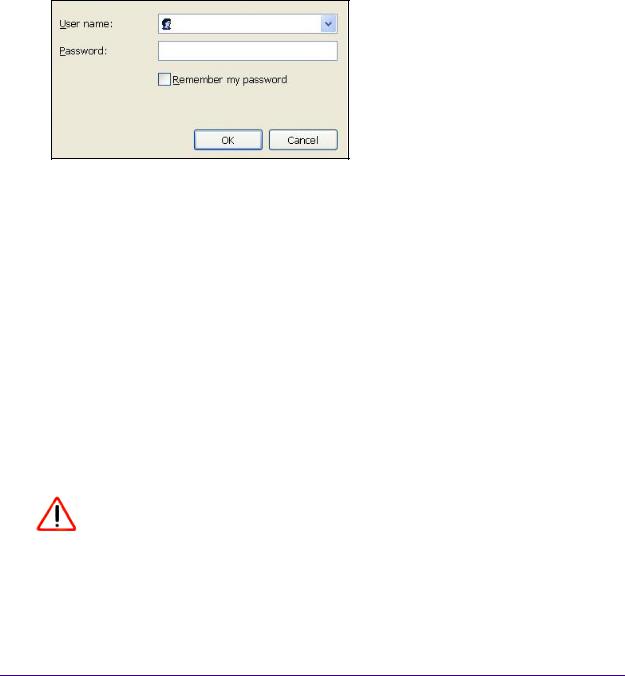
N900 Wireless Dual Band Gigabit Router WNDR4500v2
Use NETGEAR genie after Installation
When you first set up your router, NETGEAR genie starts automatically when you launch an Internet browser on a computer that is connected to the router. You can use NETGEAR genie again if you want to view or change settings for the router.
1.Launch your browser from a computer or wireless device that is connected to the router.
2.Type http://www.routerlogin.net or http://www.routerlogin.com.
A login window displays.
admin
********
3.Enter admin for the router user name and password for the router password, both in lowercase letters.
Note: The router user name and password are different from the user name and password for logging in to your Internet connection. See Types of Logins and Access on page 14 for more information.
Upgrade Router Firmware
When you set up your router and are connected to the Internet, the router automatically checks for you to see if newer firmware is available. If it is, a message is displayed on the top of the screen. See Upgrade the Router Firmware on page 77 for more information about upgrading firmware.
Click the message when it shows up, and click Yes to upgrade the router with the latest firmware. After the upgrade, the router restarts.
CAUTION:
Do not try to go online, turn off the router, shut down the computer, or do anything else to the router until the router finishes restarting and the Power LED has stopped blinking for several seconds.
Getting Started with NETGEAR genie
16
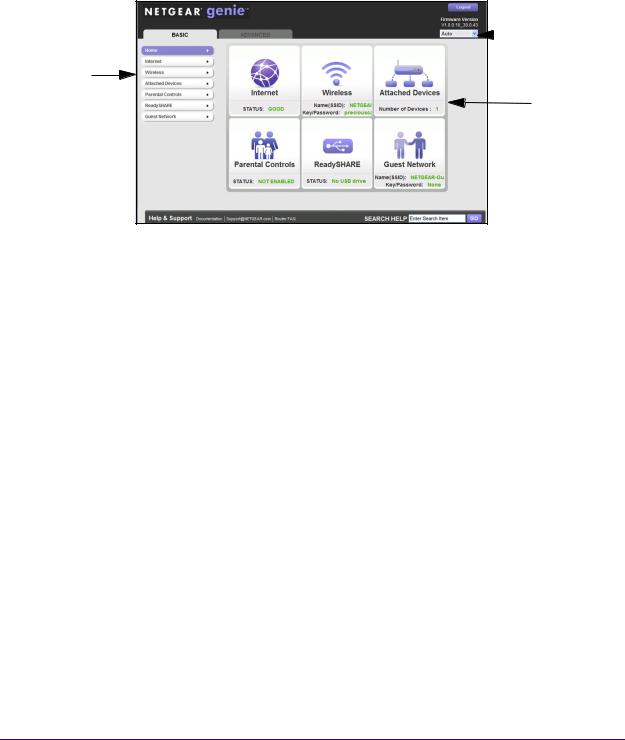
N900 Wireless Dual Band Gigabit Router WNDR4500v2
Router Dashboard (Basic Home Screen)
The router Basic Home screen has a dashboard that lets you see the status of your Internet connection and network at a glance. You can click any of the six sections of the dashboard to view more detailed information. The left column has the menus. At the top, the Advanced tab lets you access more menus and screens.
Menus |
|
Language |
|
||
|
|
|
(Click the |
|
Dashboard |
Advanced |
|
|
tab to view |
|
(Click to view |
more) |
|
details) |
 Help
Help
Figure 5. Router Basic Home screen with dashboard, language, and online help
•Home. This dashboard screen displays when you log in to the router.
•Internet. Set, update, and check the ISP settings of your router.
•Wireless. View or change the wireless settings for your router.
•Attached Devices. View the devices connected to your network.
•Parental Controls. Download and set up parental controls to prevent objectionable content from reaching your computers.
•ReadySHARE. If you connected a USB storage device to the router, then it is displayed here.
•Guest Network. Set up a guest network to allow visitors to use your router’s Internet connection.
•Advanced tab. Set the router up for unique situations such as when remote access by IP or by domain name from the Internet is needed. See Chapter 9, Advanced Settings. Using this tab requires a solid understanding of networking concepts.
•Help & Support. Go to the NETGEAR support site to get information, help, and product documentation. These links work once you have an Internet connection.
Getting Started with NETGEAR genie
17

N900 Wireless Dual Band Gigabit Router WNDR4500v2
Add Wireless Devices or Computers to Your Network
Choose either the manual or the WPS method to add wireless devices and other equipment to your wireless network. See Guest Networks on page 28 for instructions for how to set up a guest network.
Manual Method
To connect manually:
1.Open the software that manages your wireless connections on the wireless device (laptop computer, gaming device, iPhone) that you want to connect to your router. This software scans for all wireless networks in your area.
2.Look for your network and select it. If you did not change the name of your network during the setup process, look for the default Wi-Fi network name (SSID) and select it. The default SSID is on the product label on the bottom of the router.
3.Enter the router password and click Connect. The default router password is on the product label on the bottom of the router.
4.Repeat steps 1–3 to add other wireless devices.
Wi-Fi Protected Setup (WPS) Method
Wi-Fi Protected Setup (WPS) is a standard for easily adding computers and other devices to a home network while maintaining security. To use WPS, make sure that all wireless devices to be connected to the network are Wi-Fi certified and support WPS. During the connection process, the client gets the security settings from the router so that every device in the network has the same security settings.
To use WPS to join the wireless network:
1.Press the WPS button on the router front panel  .
.
2.Within 2 minutes, press the WPS button on your wireless device, or follow the WPS instructions that came with the device. The device is now connected to your router.
3.Repeat steps 1–2 to add other WPS wireless devices.
Getting Started with NETGEAR genie
18
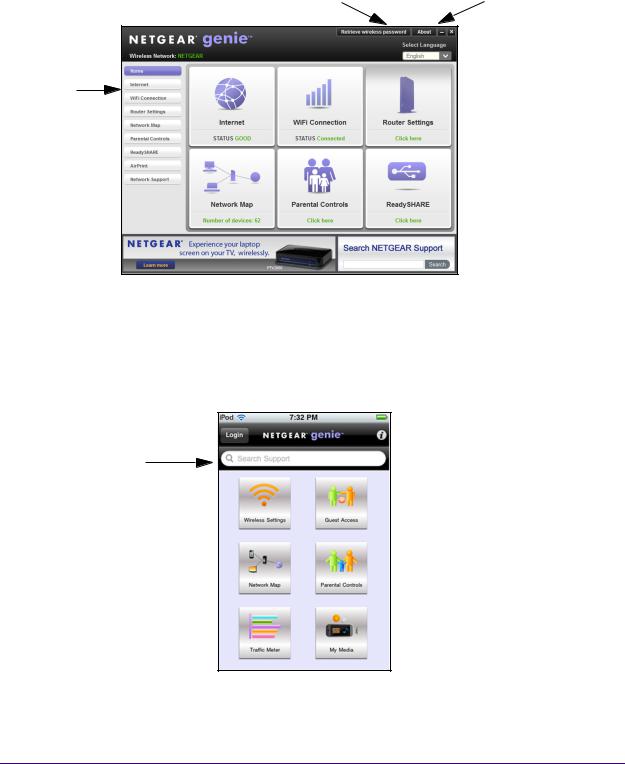
N900 Wireless Dual Band Gigabit Router WNDR4500v2
NETGEAR genie App and Mobile genie App
The genie app is the easy dashboard for managing, monitoring, and repairing your home network. See the NETGEAR genie App User Manual for details about the genie apps.
Retrieve wireless password |
About genie |
|
 Language
Language
Menu
 Dashboard (Click to view details)
Dashboard (Click to view details)
 Support
Support
The genie app can help you with the following:
•Automatically repair common wireless network problems.
•Have easy access to router features like Live Parental Controls, guest access, Internet traffic meter, speed test, and more.
The genie mobile app works on your iPhone, iPad, or Android phone:
Phone status  Log in to the router
Log in to the router 
Search NETGEAR support
 Information about genie mobile app and the connected router
Information about genie mobile app and the connected router
Getting Started with NETGEAR genie
19
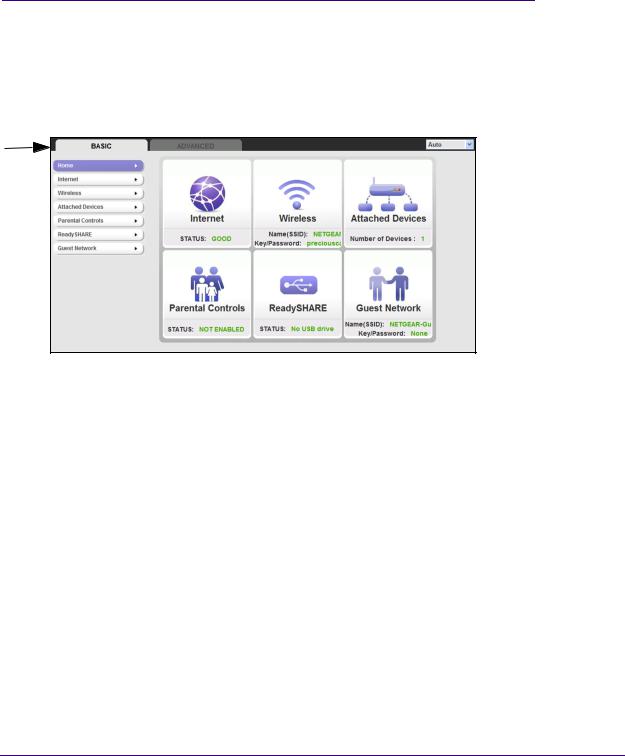
3. NETGEAR genie Basic Settings |
3 |
Your Internet connection and network |
This chapter explains the features available from the NETGEAR genie Basic Home screen, shown in the following figure:
This chapter contains the following sections:
•Internet Setup
•Attached Devices
•Parental Controls
•ReadySHARE USB Storage
•Basic Wireless Settings
•Guest Networks
20

N900 Wireless Dual Band Gigabit Router WNDR4500v2
Internet Setup
The Internet Setup screen is where you view or change ISP information.
1. From the BAsic Home screen, select Internet. The following screen displays:
Scroll to view more settings
The fields that display in the Internet Setup screen depend on whether your Internet connection requires a login.
•Yes. Select the encapsulation method and enter the login name. If you want to change the login time-out, enter a new value in minutes.
•No. Enter the account and domain names, only if needed.
2.Enter the settings for the IP address and DNS server. The default settings usually work fine. If you have problems with your connection, check the ISP settings.
3.Click Apply to save your settings.
4. Click Test to test your Internet connection. If the NETGEAR website does not display within 1 minute, see Chapter 10, Troubleshooting.
Internet Setup Screen Fields
The following descriptions explain all of the possible fields in the Internet Setup screen. The fields that display in this screen depend on whether an ISP login is required.
Does Your ISP Require a Login? Answer either yes or no.
These fields display when no login is required:
•Account Name (If required). Enter the account name provided by your ISP. This might also be called the host name.
•Domain Name (If required). Enter the domain name provided by your ISP.
These fields display when your ISP requires a login:
•Internet Service Provider Encapsulation. ISP types. The choices are PPPoE, PPTP, or L2TP.
NETGEAR genie Basic Settings
21

N900 Wireless Dual Band Gigabit Router WNDR4500v2
•Login. The login name provided by your ISP. This is often an email address.
•Password. The password that you use to log in to your ISP.
•Idle Timeout (In minutes). If you want to change the login time-out, enter a new value in minutes. This setting determines how long the router keeps the Internet connection active after there is no Internet activity from the LAN. Entering a value of 0 (zero) means never log out.
Internet IP Address.
•Get Dynamically from ISP. Your ISP uses DHCP to assign your IP address. Your ISP automatically assigns these addresses.
•Use Static IP Address. Enter the IP address, IP subnet mask, and the gateway IP address that your ISP assigned. The gateway is the ISP router to which your router connects.
Domain Name Server (DNS) Address. The DNS server is used to look up site addresses based on their names.
•Get Automatically from ISP. Your ISP uses DHCP to assign your DNS servers. Your ISP automatically assigns this address.
•Use These DNS Servers. If you know that your ISP does not automatically transmit DNS addresses to the router during login, select this option, and enter the IP address of your ISP primary DNS server. If a secondary DNS server address is available, enter it also.
Router MAC Address. The Ethernet MAC address used by the router on the Internet port. Some ISPs register the MAC address of the network interface card in your computer when your account is first opened. They accept traffic only from the MAC address of that computer. This feature allows your router to use your computer’s MAC address (this is also called cloning).
•Use Default Address. Use the default MAC address.
•Use Computer MAC Address. The router captures and uses the MAC address of the computer that you are now using. You have to use the one computer that the ISP allows.
•Use This MAC Address. Enter the MAC address that you want to use.
NETGEAR genie Basic Settings
22
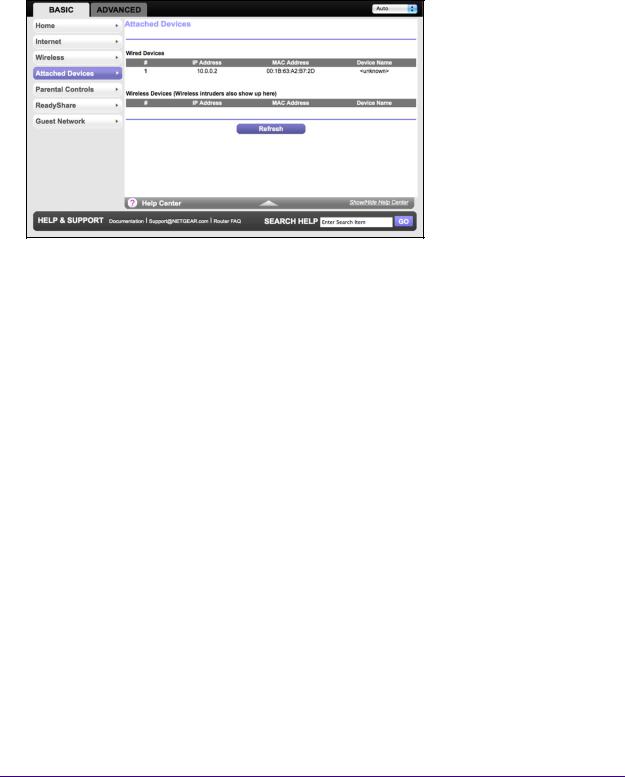
N900 Wireless Dual Band Gigabit Router WNDR4500v2
Attached Devices
You can view all computers or devices that are currently connected to your network here. From the Basic Home screen, select Attached Devices to display the following screen:
Wired devices are connected to the router with Ethernet cables. Wireless devices have joined the wireless network.
•# (number). The order in which the device joined the network.
•IP Address. The IP address that the router assigned to this device when it joined the network. If a device is disconnected and rejoins the network, this number can change.
•MAC Address. The unique MAC address for each device does not change. The MAC address is typically shown on the product label.
•Device Name. If the device name is known, it is shown here.
You can click Refresh to update this screen.
NETGEAR genie Basic Settings
23
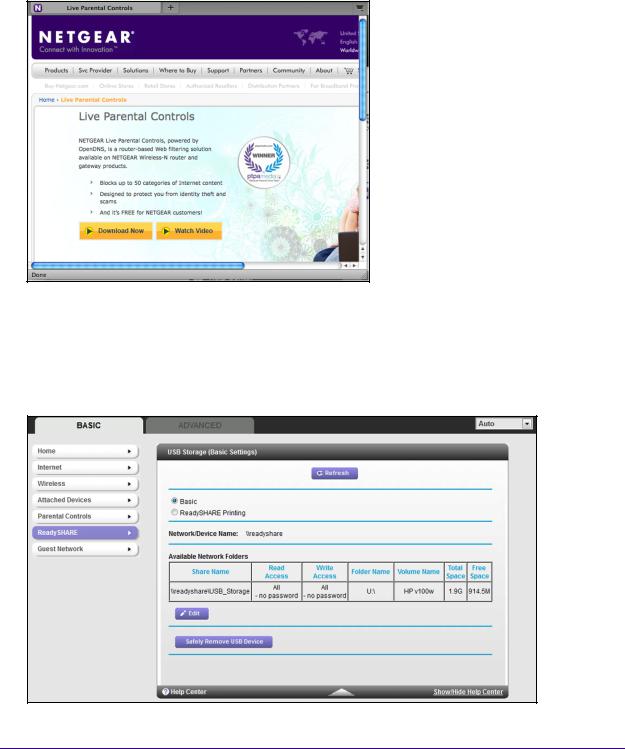
N900 Wireless Dual Band Gigabit Router WNDR4500v2
Parental Controls
The first time you select Parental Controls from the Basic Home screen, you are automatically directed to the Internet, where you can learn more about Live Parental Controls or download the application. The following screen displays:
ReadySHARE USB Storage
You can view information about a USB storage device that is connected to the router’s USB port here. From the Basic Home screen, select ReadySHARE to display the USB Storage (Basic Settings) screen:
NETGEAR genie Basic Settings
24

N900 Wireless Dual Band Gigabit Router WNDR4500v2
This screen displays the following:
•Network/Device Name. The default is \\readyshare. This is the name used to access the USB device connected to the router.
•Available Network Folders. The folders on the USB device.
Share Name. If only one device is connected, the default share name is USB_Storage. You can click the name shown, or you can type it in the address field of your web browser. If Not Shared is shown, the default share has been deleted, and no other share for the root folder exists. To change this setting, click the link.
Read Access and Write Access. Shows the permissions and access controls on the network folder: All – no password (the default) allows all users to access the network folder. The user name (account name) for All – no password is guest. The password for admin is the same one that you use to log in to the router. By default, it is password.
Folder Name. Full path used by the network folder.
Volume Name. Volume name from the storage device (either USB drive or HDD).
Total Space and Free Space. Shows the current utilization of the storage device.
•Edit. Click the Edit button to edit the Available Network Folders settings.
•Safely Remove a USB Device. Click to safely remove the USB device attached to your router.
You can click Refresh to update this screen.
For more information about USB storage, see Chapter 5, USB Storage.
Basic Wireless Settings
The Wireless Settings screen lets you view or configure the wireless network setup.
The router comes with preset security. This means that the Wi-Fi network name (SSID), network key (password), and security option (encryption protocol) are preset in the factory. You can find the preset SSID and password on the bottom of the unit.
Note: The preset SSID and password are uniquely generated for every device to protect and maximize your wireless security.
NETGEAR recommends that you do not change your preset security settings. If you do decide to change your preset security settings, make a note of the new settings and store it in a safe place where you can easily find it.
To view or change basic wireless settings:
If you use a wireless computer to change the wireless network name (SSID) or other wireless security settings, you are disconnected when you click Apply. To avoid this problem, use a computer with a wired connection to access the router.
NETGEAR genie Basic Settings
25
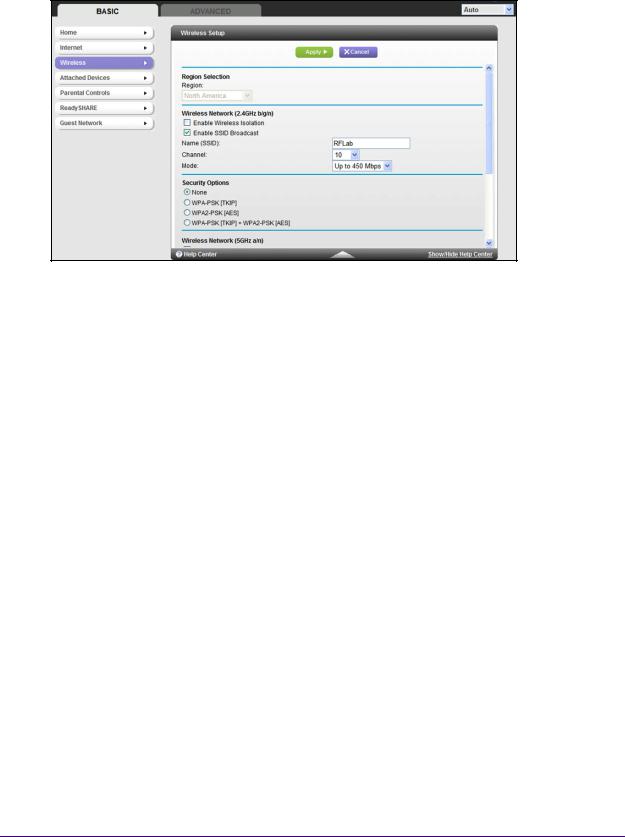
N900 Wireless Dual Band Gigabit Router WNDR4500v2
1. On the Basic Home screen, select Wireless to display the Wireless Settings screen.
You can scroll down to view the 5 GHz wireless network settings. The screen sections, settings, and procedures are explained in the following sections.
2.Make any changes that are needed, and click Apply to save your settings.
3.Set up and test your wireless devices and computers to make sure that they can connect wirelessly. If they do not, check the following:
•Is your wireless device or computer connected to your network or another wireless network in your area? Some wireless devices automatically connect to the first open network (without wireless security) that they discover.
•Does your wireless device or computer show up on the Attached Devices screen? If it does, it is connected to the network.
•If you are not sure what the network name (SSID) or password is, look on the label on the bottom of your router.
Wireless Settings Screen Fields
Region Selection
The location where the router is used. Select from the countries in the list. In the United States, the region is fixed to United States and is not changeable.
Wireless Network
2.4 GHz b/g/n and 5.0 GHz a/n
The b/g/n and a/n notation references the 802.11 standards of conformance. For example, the 2.4 b/g/n conforms to 802.11b, 802.11g, and 802.11n at 2.4-GHz radio frequency.
NETGEAR genie Basic Settings
26
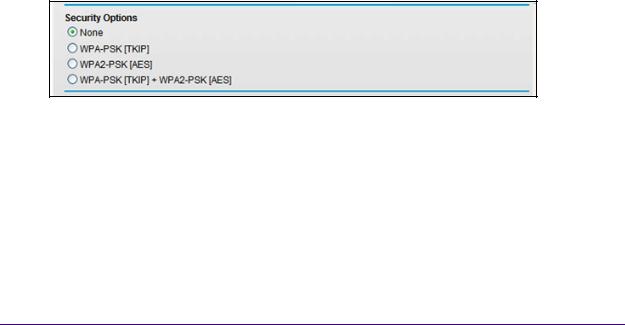
N900 Wireless Dual Band Gigabit Router WNDR4500v2
Enable Wireless Isolation. If this check box is selected, wireless clients (computers or wireless devices) that join the network can use the Internet, but cannot access each other or access Ethernet devices on the network.
Enable SSID Broadcast. This setting allows the router to broadcast its SSID so wireless stations can see this wireless name (SSID) in their scanned network lists. This check box is selected by default. To turn off the SSID broadcast, clear the check box, and click Apply.
Name (SSID). The SSID is also known as the wireless network name. Enter a 32-character (maximum) name in this field. This field is case-sensitive. The default SSID is randomly generated, and NETGEAR strongly recommends that you do not change this setting.
Channel. This setting is the wireless channel used by the gateway. Enter a value from 1 through 13. (For products in the North America market, only Channels 1 through 11 can be operated.) Do not change the channel unless you experience interference (shown by lost connections or slow data transfers). If this happens, experiment with different channels to see which is the best.
Mode. Up to 217 Mbps is the default and allows 802.11n and 802.11g wireless devices to join the network. g & b supports up to 54 Mbps. The Up to 450-Mbps setting allows 802.11n devices to connect at this speed.
Security Options Settings
The Security Options section of the Wireless Settings screen lets you change the security option and passphrase. NETGEAR recommends that you do not change the security option or passphrase, but if you want to change these settings, this section explains how.
Do not disable security.
Change WPA Security Option and Passphrase
1.Under Security Options, select the WPA option you want.
2.In the Passphrase field that displays when you select a WPA security option, enter the network key (passphrase) that you want to use. It is a text string from 8 to 63 characters.
NETGEAR genie Basic Settings
27

N900 Wireless Dual Band Gigabit Router WNDR4500v2
Guest Networks
Adding a guest network allows visitors at your home to use the Internet without giving them your wireless security key. You can add a guest network to each wireless network: 2.4 GHz b/g/n and 5.0 GHz a/n.
To set up a guest network:
1. Select Basic > Guest Network:
2.For a 5-GHz network, scroll down to view that section of the Guest Network screen.
3.Select any of the following wireless settings:
Enable Guest Network. When this check box is selected, the guest network is enabled, and guests can connect to your network using the SSID of this profile.
Enable Wireless Isolation. If this check box is selected, wireless clients (computers or wireless devices) that join the network can use the Internet, but cannot access each other or access Ethernet devices on the network.
Enable SSID Broadcast. If this check box is selected, the wireless access point broadcasts its name (SSID) to all wireless stations. Stations with no SSID can adopt the correct SSID for connections to this access point.
Allow guest to access My Local Network. If this check box is selected, any user who connects to this SSID has access to your local network, not just Internet access.
4.Give the guest network a name.
The guest network name is case-sensitive and can be up to 32 characters. You then manually configure the wireless devices in your network to use the guest network name in addition to the main nonguest SSID.
5.Select a security option from the list. The security options are described in Guest Network Wireless Security Options on page 29.
6.Click Apply to save your selections.
NETGEAR genie Basic Settings
28

N900 Wireless Dual Band Gigabit Router WNDR4500v2
Guest Network Wireless Security Options
A security option is the type of security protocol applied to your wireless network. The security protocol in force encrypts data transmissions and ensures that only trusted devices receive authorization to connect to your network. Wi-Fi Protected Access (WPA) has several options including pre-shared key (PSK) encryption.
This section presents an overview of the security options and provides guidance on when to use which option. It is also possible to set up a guest network without wireless security. NETGEAR does not recommend this.
WPA Encryption
WPA encryption is built into all hardware that has the Wi-Fi-certified seal. This seal means that the product is authorized by the Wi-Fi Alliance (http://www.wi-fi.org/) because it complies with the worldwide single standard for high-speed wireless local area networking.
WPA uses a passphrase to authenticate the client and generate the initial data encryption keys. Then it dynamically varies the encryption key. WPA-PSK uses Temporal Key Integrity Protocol (TKIP) data encryption, implements most of the IEEE 802.11i standard, and is designed to work with all wireless network interface cards, but not all wireless access points. It is superseded by WPA2-PSK.
WPA2-PSK is stronger than WPA-PSK. It is advertised to be theoretically indecipherable due to the greater degree of randomness in encryption keys that it generates. WPA2-PSK gets higher speed because it is typically implemented through hardware, while WPA-PSK is typically implemented through software. WPA2-PSK uses a passphrase to authenticate and generate the initial data encryption keys. Then it dynamically varies the encryption key.
WPS-PSK + WPA2-PSK Mixed Mode can provide broader support for all wireless clients. WPA2-PSK clients get higher speed and security, and WPA-PSK clients get decent speed and security. The product documentation for your wireless adapter and WPA client software should have instructions about configuring their WPA settings.
NETGEAR genie Basic Settings
29
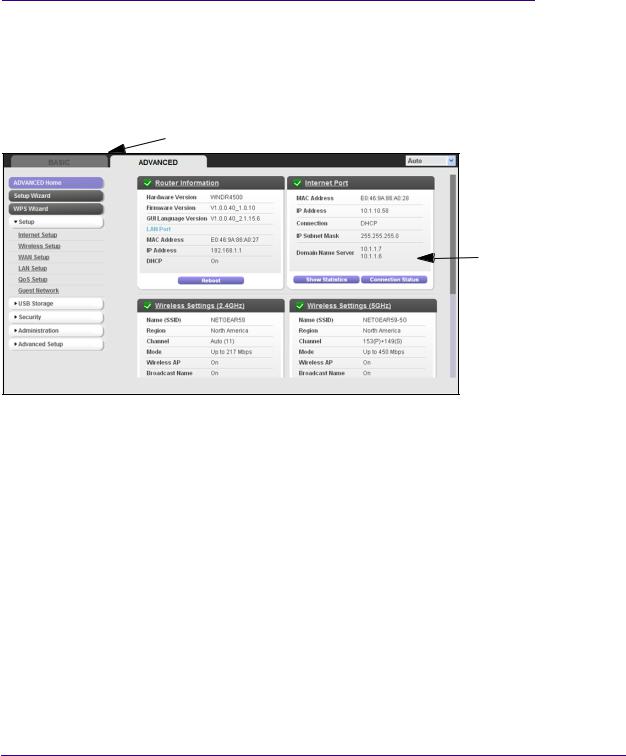
4. NETGEAR genie Advanced Home |
4 |
Specifying custom settings |
This chapter explains the features available from the NETGEAR genie Advanced Home screen, shown in the following figure:
This screen is also displayed through the Administration menu.
This chapter contains the following sections:
•Setup Wizard
•WPS Wizard
•Setup Menu
•WAN Setup
•LAN Setup
•Quality of Service (QoS) Setup
Some selections on the Advanced Home screen are described in separate chapters:
•USB Storage. See Chapter 5, USB Storage.
•Security. See Chapter 7, Security.
•Administration. See Chapter 8, Administration.
•Advanced Setup. See Chapter 9, Advanced Settings.
30
